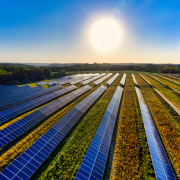AgriSolar News Roundup: Solar Pollinator Habitat in Minnesota, Agrisolar Industries in US, Europe and Asia, Dominion Energy Lambscaping, Solar Grazing in Kentucky, Virginia Solar Pollinators, Solar Restores Biocrusts
US Agriculture Industry Demonstrates Ability to Embrace New Technologies and Practices
“The rising tide of opposition to large-scale solar farms has been impacting the US solar industry, but over the long run, PV stakeholders have the butterflies on their side. Solar developers are eager to pitch their projects as pollinator habitats that replace cultivated crops and neglected land with native plants, benefiting the property owner and nearby farms. The pollinator angle helps to undercut complaints that solar arrays are an inappropriate use of farmland, and it supports the case for farmers to adopt new technologies that benefit their industry.
Minnesota has become the epicenter of the solar-plus-pollinator trend, with local electric cooperative Connexus Energy leading the way. That’s no accident. A 2016 state law set up Minnesota’s Habitat Friendly Solar program, which incentivizes property owners and solar developers to claim benefits for gamebirds as well as songbirds and pollinating insects.” – Cleantechnica
Agrisolar Can Lower Food Costs, Reduce Emissions, and Improve Farming
“The agricultural industries in Europe, Asia and the United States have been aggressively expanding their agrivoltaic farms with wide public support. In Europe, solar panels are put over different types of crops, including fruit trees. Meanwhile, in China, agrivoltaics is used to reverse desertification which is literally using solar panels to green former deserts.
The life cycle analysis of agrivoltaics, which assesses its impact from its conception to use, found that these solar-covered farms emit 69.3 per cent less greenhouse gases and demand 82.9 per cent less fossil energy compared to separate food farms and solar farms-based production.” – Morning Ag Clips
Dominion Energy Lambscaping on Solar Sites
“As part of Dominion’s solar grazing program, sheep clean up more than 40 acres a day across five of their solar farms. ‘We are trying to get creative and innovative in ways in vegetation management,’ said Dominion Energy spokesperson Tim Eberly. It’s more environmentally friendly, too, because it saves emissions generated by lawn mowing equipment.
The digested grass and manure also help improve water filtration from rain, which provides a cooling aspect for more than 80,000 solar panels, which, in turn, also makes them more efficient.” – WTKR
Kentucky Farm Uses Sheep to Graze Solar Site
“Since 2020, Shetland and Katadin sheep have been roaming and eating grass on the 50-acre solar facility in Harrodsburg, southeast of Lexington. What started out as 25 sheep in the flock has grown to 200 sheep.
‘By using sheep rather than lawnmowers, what we‘re doing here is both more environmentally friendly and helps manage expenses by keeping maintenance costs down. We also hope our unique approach can be a model for other utilities and their solar initiatives.’ Aron Patrick, director of Research and Development at LG&E and KU parent company PPL Corporation, said in a news release Wednesday.” – WDRB
Hexagon Energy Plans to Develop Pollinator Habitat on Solar Site
“Charlottesville-based Hexagon Energy hopes to install solar panels on 650 acres near Scottsville. After 80 years of tree farming, the land there is exhausted, so Hexagon’s Scott Remer says the company will cultivate native grasses and flowers to restore the soil.
‘It’s about 500 acres of meadow habitat that’s actually going to be established from a cutover moonscape right now to about 500 acres of meadow habitat, and that’s not even counting clover and plants and flowers and grasses that are under the panels,’” – WVTF
Thistlerock Meadery is set to keep 100 hives on the solar site once development is completed.
Research Shows Solar Shade Helps Restore Biocrusts
“Arizona State University (ASU) professor Ferran Garcia-Pichel and his research team have proposed to use solar arrays as a solution to the problem of excess heat and light, creating a shaded nursery to promote biocrust growth.
The researchers performed a proof-of-concept experiment in the Sonoran Desert, studying biocrust growth for three years. During the study, the PV array promoted biocrust formation, doubling biocrust total biomass and tripling its coverage area when compared to open areas with similar soil characteristics. Natural recovery of harvested biocrusts can take six to eight years to recuperate without intervention, but re-inoculated areas under the solar panels were able to nearly fully recover within one year.” – PV Magazine
More information on this research can be found here.


